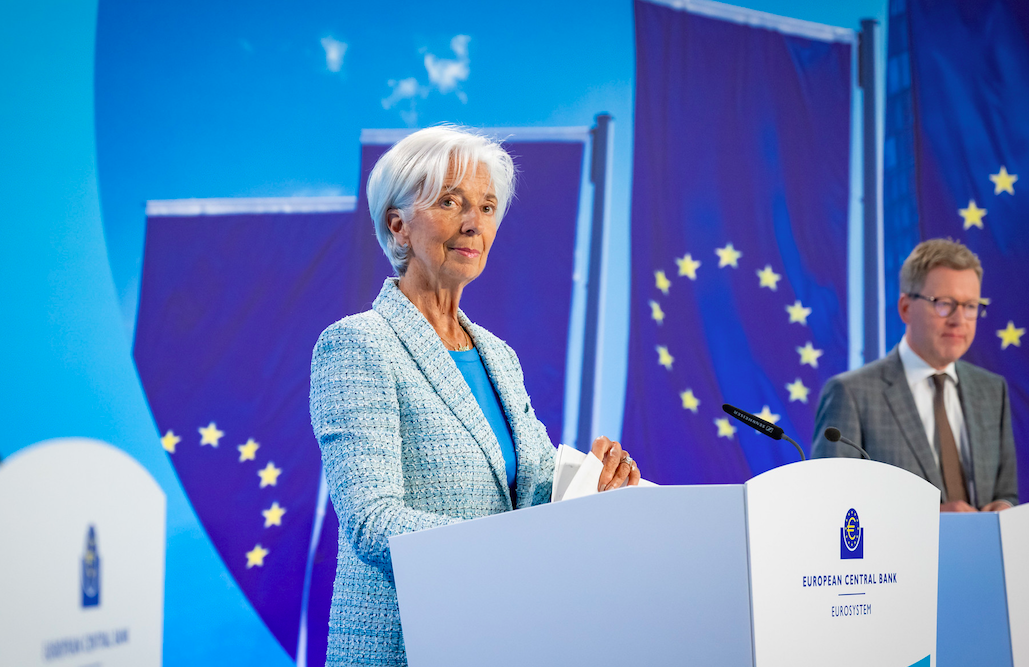The European Central Bank (ECB), which did not disappoint in its meeting yesterday, has taken the lead over the Fed. However, experts from international asset management firms note that the ECB has made this first-rate cut without providing firm guidance beyond June.
The Governing Council justified the moderation of policy restriction based on greater confidence in the disinflation process and the strength of monetary transmission. Expert projections on growth were revised upwards. ECB President Christine Lagarde was clear: “We are determined to ensure that inflation returns to our 2% target in the medium term. We will keep official interest rates at sufficiently restrictive levels for as long as necessary to achieve this goal. We will continue to apply a data-dependent approach, making decisions at each meeting to determine the appropriate level and duration of restriction. In particular, our decisions on interest rates will be based on our assessment of inflation prospects considering new economic and financial data, underlying inflation dynamics, and the intensity of monetary policy transmission, without committing to any specific rate path in advance.”
Beyond the official statement, firms maintain that Lagarde’s subsequent declaration refrained from committing to future cuts and maintained a data-dependent stance. “It is likely that recent wage and inflation surprises will keep Council members in a cautious position. Therefore, a cut in July seems clearly ruled out. The ECB’s rate trajectory will depend on data evolution from now on and the Fed, which we believe cannot cut rates this year due to the rigidity of U.S. inflation,” says Salman Ahmed, Global Head of Macro and Strategic Asset Allocation at Fidelity International.
Officials not only referred to data dependency but also to flexibility. Indeed, the monetary policy decision statement was clear: “The Governing Council does not commit in advance to follow a determined rate path.” Felix Feather, Economist at abrdn, believes that in practice, the data-dependent approach is likely to be cautious. “The ECB will have little additional data before its July meeting. In particular, there will be no reliable data on second-quarter wage growth. Therefore, we consider that reiterating the emphasis on data dependency is consistent with our request to keep the deposit rate at 3.75% in July.”
Hugo Le Damany and François Cabau, Economist and Senior Economist for the Eurozone at AXA Investment Managers, consider the approach to be cautious but exaggerated. “We believe the ECB made this decision because it considers this rate cut relatively safe, with no significant risk of re-stimulating subsequent inflationary pressures. However, the ECB immediately reminded that internal price pressures remain strong. They reiterated that official interest rates will remain restrictive for as long as necessary to timely achieve their medium-term 2% target. The Governing Council insisted they will remain data-dependent and not commit to any specific rate path in advance,” they explain.
So far, the market reaction has not been very violent, but volatility persists in sovereign debt amid growing rhetoric that rates will take longer to return to expected levels, concentrating the likelihood of more cuts in the last quarter meetings of the year. “In the stock markets, attention is increasingly focused on upward revisions of corporate profits, although the banking sector performed well during the session due to the ECB’s hawkish tone, which augurs better margins for the rest of the year,” explains Carlos del Campo from Diaphanum’s investment team.
Forecast on upcoming cuts
In light of Lagarde’s words, Ulrike Kastens, Economist for Europe at DWS, estimates that the ECB will pause in July before “probably,” she notes, cutting rates again in September and December. “Data dependency remains key. At the same time, the upward revision of inflation forecasts for 2025 suggests that it may now take longer to reach the inflation target. These forecasts are much more restrictive than expected and imply very gradual rate cuts,” she argues.
Mauro Valle, Head of Fixed Income at Generali AM, part of the Generali Investments ecosystem, believes the ECB has room to cut again in the second half of the year, as monetary policies will still be perceived as restrictive. “The debate revolves around the probabilities of a third cut in December 2024: the market is pricing about a 50% probability, while our analysis indicates three cuts. The decision will depend on upcoming economic data, mainly inflation and wage trends, as Lagarde reiterated during the press conference,” Valle notes.
“Given the ECB’s reaction function, we anticipate the entity will continue cutting rates in meetings where projections are evaluated. September offers the next opportunity to globally reassess the disinflation process. Unlike earlier this year, market prices seem reasonable and generally align with our baseline of three cuts for this year. We expect additional cuts in September and December. Risks tilt towards fewer cuts, especially due to the rigidity of service inflation, labor market resilience, financial condition easing, and the ECB’s risk management considerations,” adds Konstantin Veit, Portfolio Manager at PIMCO.
Tomasz Wieladek, Chief Economist at T. Rowe Price, also shares his forecast: “I believe the ECB will end up making two more cuts this year. The bar for new short-term surprises in its forecasts is high. However, markets should not expect any future guidance. All of this year’s future rate cuts will likely be hawkish. However, this purely data-dependent approach also means the ECB could easily cut less than twice. We might only see one more cut towards the end of the year if inflation remains much more persistent than expected.”
In this regard, Axel Botte, Head of Market Strategy at Ostrum AM (Natixis IM), recalls that it was not a unanimous decision. “This implies that the prior commitment to a cut may have been largely motivated by political reasons. In fact, the ECB raised its inflation forecast to an average of 2.2% for next year but kept it at 1.9% for 2026. In any case, Christine Lagarde struggled to justify a rate cut at a time when wage increases remain uncomfortably high. Wage growth should hover around 4% until the end of 2024. The ECB’s message is hard to understand, as ECB rate cuts are applied alongside quantitative tightening. Still, the ECB could cut more in September when it updates its macroeconomic forecasts,” Botte adds.
Divergence with the Fed
For international asset managers, yesterday’s ECB decision is also relevant because it shows the divergence between the European institution and the Fed, something that hasn’t happened since 2011. “The real point of interest is to know how far the ECB can diverge from the Federal Reserve. We believe the scope of this divergence will be limited, given the incipient signs of a slowdown in the U.S. will give the Fed room to ease rates. This is our base scenario and means we see minimal risk of importing inflation. However, any prolonged divergence in policy could have a side effect on the currency market,” notes Monica Defend, Head of the Amundi Investment Institute.
Tim Winstone, Portfolio Manager in the Corporate Credit team at Janus Henderson, believes we started seeing a divergence in central bank communication earlier this year. “Compared to Europe, demand-driven inflation in the U.S. has been firmer; growth/employment, better; and the consumer, exceptionally strong. The Eurozone economy is experiencing less rigid inflation, largely driven by energy prices. This divergence provides us an opportunity as active managers,” explains Winstone.



